Related Research Articles
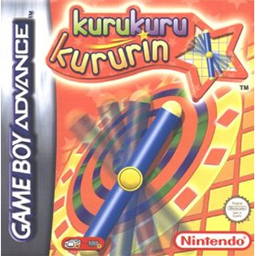
Kuru Kuru Kururin is a puzzle video game developed by Eighting and published by Nintendo for the Game Boy Advance handheld video game console. It was released in Japan on March 21, 2001, and in Europe and Australia on June 22 as a launch title. North America saw the title for the first time in February 2016, via the Wii U's Virtual Console service. Kuru Kuru Kururin is the first title in the Kururin series and was followed by two Japan-only sequels, Kururin Paradise and Kururin Squash!. The game was released on the Nintendo Switch Online + Expansion Pack in February 2023.
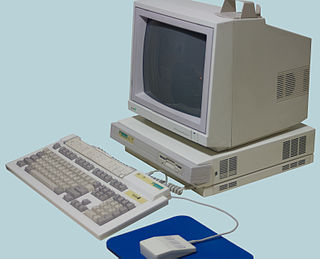
Acorn Archimedes is a family of personal computers designed by Acorn Computers of Cambridge, England. The systems are based on Acorn's own ARM architecture processors and the proprietary operating systems Arthur and RISC OS. The first models were introduced in 1987, and systems in the Archimedes family were sold until the mid-1990s.
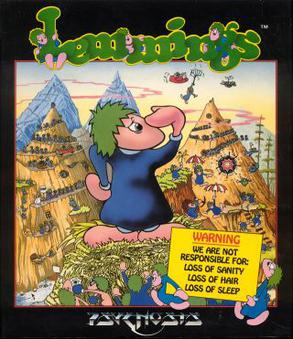
Lemmings is a puzzle–strategy video game originally developed by DMA Design and published by Psygnosis for the Amiga in 1991 and later ported for numerous other platforms. The game was programmed by Russell Kay, Mike Dailly and David Jones, and was inspired by a simple animation that Dailly created while experimenting with Deluxe Paint.

Elite is a space trading video game. It was written and developed by David Braben and Ian Bell and originally published by Acornsoft for the BBC Micro and Acorn Electron computers in September 1984. Elite's open-ended game model, and revolutionary 3D graphics led to it being ported to virtually every contemporary home computer system and earned it a place as a classic and a genre maker in gaming history. The game's title derives from one of the player's goals of raising their combat rating to the exalted heights of "Elite".

Dark Chronicle, released as Dark Cloud 2 in North America, is a 2002 action role-playing game developed by Level-5 and published by Sony Computer Entertainment for the PlayStation 2 (PS2). It was released in Japan before releasing in English in 2003. An emulated version of the game was released for the PlayStation 4 through the PlayStation Network in 2016.

Aliens: Colonial Marines is a 2013 first-person shooter developed by Gearbox Software and published by Sega for PlayStation 3, Windows, and Xbox 360. Based on the Alien universe and set shortly after the events of James Cameron's 1986 film Aliens, the game follows a group of Colonial Marines, a fictional military unit, as they confront the Weyland-Yutani corporation in an effort to rescue survivors from the Sulaco spaceship. The game features a campaign mode that supports both single-player and cooperative gameplay, and a multiplayer mode in which players compete in different scenarios.
A cooperative video game, often abbreviated as co-op, is a video game that allows players to work together as teammates, usually against one or more non-player character opponents (PvE). Co-op games can be played locally using one or multiple input controllers or over a network via local area networks, wide area networks, or the Internet.
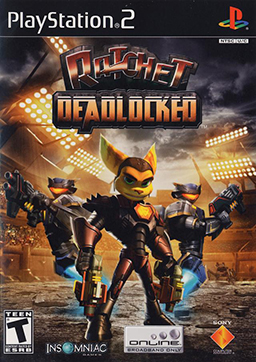
Ratchet: Deadlocked is a 2005 action platformer, developed by Insomniac Games and published by Sony Computer Entertainment for the PlayStation 2 as the fourth installment of the Ratchet & Clank series.
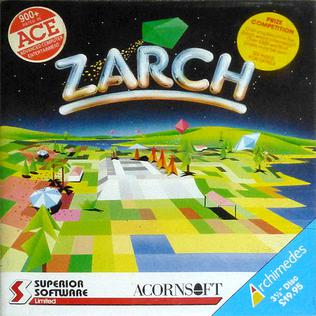
Zarch is a computer game developed by David Braben in 1987, for the release of the Acorn Archimedes computer. Zarch started off as a demo called Lander which was bundled with almost all releases of the Acorn Archimedes.
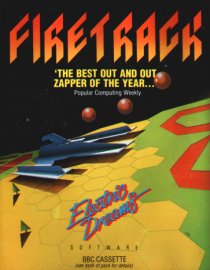
Firetrack is a vertically-scrolling shooter programmed by Nick Pelling and released for the BBC Micro and Commodore 64 platforms in 1987 by Electric Dreams Software. It was also ported to the Acorn Electron by Superior Software in 1989 as part of the Play It Again Sam 7 compilation. It resembles the 1984 arcade game Star Force in style and gameplay. The game was technically advanced and very well received by critics.

Perfect Dark is a 2000 action game developed and published by Rare for the Game Boy Color. As a direct prequel to its Nintendo 64 counterpart, the game follows agent Joanna Dark as she completes her training at the Carrington Institute research centre and uncovers information against rival corporation dataDyne. The gameplay revolves around shooting opponents and completing objectives such as rescuing hostages or recovering items. The game also includes a multiplayer mode where two players may compete against each other in several deathmatch modes.
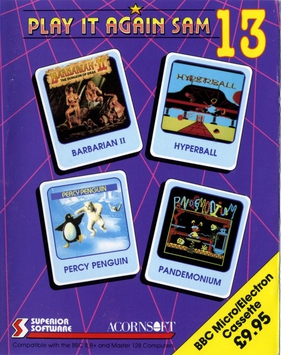
Hyperball is a clone of the 1986 arcade game Arkanoid created for the Acorn Electron and BBC Micro. It was released as part of the compilation Play It Again Sam 13 in 1990.
Provocator is a shoot 'em up video game developed for the Acorn Archimedes range of computers. It was the first game by Network 23 and was published in the summer of 1991 by C.T.S. to critical acclaim.

Prey is a first-person shooter video game developed by Arkane Austin and published by Bethesda Softworks. It was released worldwide on 5 May 2017, for PlayStation 4, Windows, and Xbox One.

XCOM: Enemy Unknown is a 2012 turn-based tactics video game developed by Firaxis Games and published by 2K. The game is a "reimagined" version of the 1994 strategy game X-COM: UFO Defense and a reboot of MicroProse's 1990s X-COM series. Set in an alternative version of the year 2015, the player controls an elite multinational paramilitary organization called XCOM during an alien invasion of Earth. The player commands troops in the field in a series of turn-based tactical missions; between missions, the player directs the research and development of technologies from recovered alien technology and captured prisoners, expands XCOM's base of operations, manages finances, and monitors and responds to alien activity.
This list includes terms used in video games and the video game industry, as well as slang used by players.
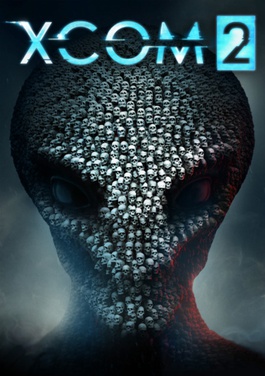
XCOM 2 is a 2016 turn-based tactics video game developed by Firaxis Games and published by 2K. It is the sequel to 2012's reboot of the series, XCOM: Enemy Unknown; it takes place 20 years after the events of Enemy Unknown. XCOM, a military organization trying to fight off an alien invasion, has lost the war and is now a resistance force against the occupation of Earth and the established totalitarian regime and military dictatorship. Gameplay is split between turn-based combat in which players command a squad of soldiers to fight enemies, and strategy elements in which players manage and control the operations of the Avenger, an alien ship that is used as a mobile base for XCOM.

The Dungeon is a single player real-time role-playing video game featuring a 3D first-person perspective with texture mapping. It was published by The Fourth Dimension for the Acorn Archimedes home computer in 1993.

Alien Odyssey is an action-adventure game developed by Argonaut Software and published by Philips Media in 1995. The game features a mixture of first-person and third-person gameplay, with sequences involving shooter, adventure and puzzle mechanics. Alien Odyssey makes use of 3D rendering and full motion video cutscenes which were developed using the developer's proprietary B-Render graphics software. Upon release, the game received a mixed reception, with reviewers praising the visual presentation of the game, whilst critiquing the game's inconsistent mixture of game modes and short length.
References
- ↑ Dabs Press (August 1992), "Games Action from Alien Images", Acorn User, p. 110, archived from the original on 2013-01-16, retrieved 2012-11-06
- 1 2 Porter, Will (2011). "Retrospective: The Acorn Archimedes". EUROGAMER. Archived from the original on 2012-10-20. Retrieved 21 October 2012.
- ↑ Greenhill, Sam (December 1990), "Game Show - Top 10 Archimedes Games", BBC Acorn User, pp. 135–140, archived from the original on 2013-01-16, retrieved 2012-11-06